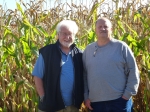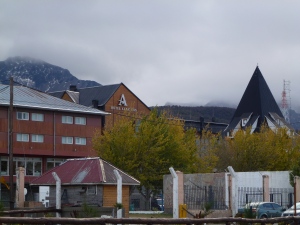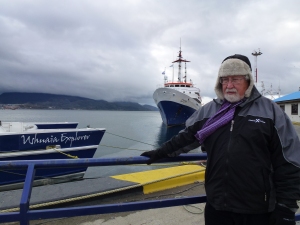Part I of the “Northern Bliss/Heritage Home” blog series
August 2012, Balsam Lake, Wisconsin
“What will happen to all your beautiful flowers when we leave here in three weeks?” Gunter asks as he watches me just a’diggin’ in the dirt.
I’ve been gardening for over two hours this morning. Enhancing the flower gardens here at our lake home is more than just a chore. I am returning to my roots. I was born in Polk County, Wisconsin—in Cushing, less than 30 miles from here.
I set my tools down and move my kneeling pad over to the next clump of weeds to be pulled. “Leave? I’m just settling in, marking my territory.”
Digging in the dirt has become a compulsion since we moved many of our belongings from San Diego in mid-July.
“This reminds me of carrying pails and pails of water for my mother’s and grandmother’s gardens,” Gunter answers. He points to the foxgloves. “The flowers in Bavaria were very similar to these. Only the flowers had different names.”

Foxglove (Digitalis Purpurea)

Huge hydrangea

Tiger lilies grow well in Wisconsin
I’m not sure how to explain this drive to dig in the dirt, to go back to one’s roots. The compulsion comes from deep within and the process provides deep satisfaction. And when I’m all tired out, my chores completed for the morning, Gunter says I always return with a smile on my face. So it must be good for me.
Even though I’ve been a sailor throughout much of my life, and made my home on the sea for eight years, as a farmer’s daughter, the need to return to the land is a primal instinct. This is not unusual. Captain Cook, who sailed farther than any man had sailed before, retired on a farm in England near where he grew up, that is, until he was called back to sea again for his final voyage.
This land also provides for me a sense of completion. My family lost its dairy farm to foreclosure after the dreaded Bang’s Disease swept through the herd and the milk could not be sold. I was a freshman in college at the time, and I never had an opportunity to say good-bye to that land. It all happened so fast. Perhaps that created a longing in me that I’ve buried as deep as the foxgloves I have planted here.
If so, that longing didn’t surface until I attended my 50th class reunion in St. Croix Falls in September, 2010. I rarely attended reunions, and may not have come to this one had not my granddaughter scheduled her wedding the week prior. During the event, a classmate of mine asked me, “Are you here to look at a summer home?” Her question startled me. “Lake homes here are selling for half of what they were before the 2008 crash.”
That comment set the process in motion.
For the next two days, Gunter and I drove through the countryside admiring the fall foliage. “I love all the deep blue lakes, the lush rolling hills, and the wonderful colors. It reminds me of my own roots in Bavaria,” Gunter exclaimed.
“That’s probably why so many German immigrants settled in Wisconsin,” I replied. “They must have thought the same thing.”
“Lots of FOR SALE signs around here,” he noted. “Interested?”
My heart skipped a beat. “Yes! The home should be here in Polk County.”
Now why did I say that? I’ve never even thought of buying a home here. Not sure I want this. Too many memories—not all of them pleasant.
But the die was cast. Actually, the die had been cast two years earlier, when we completed our world circumnavigation. The planned trilogy, “In Search of Adventure and Moments of Bliss,” would cover the eight years of our sailing adventures. But even then, I thought about writing a book about what happened in the years before we left to go sailing.
During presentations promoting the first book in the series, MAIDEN VOYAGE, many readers asked about our lives before sailing. That would make an interesting story: how did a farm girl from Wisconsin who wanted to escape her past and succeed at business and a boy from Munich who loved math and science meet each other—after many wrong turns in life—and become soul mates?
What would I need to do to write such a book?
I would need to pick up the dialect I’d forgotten. I would need to stay where I grew up for a while to re-acquaint myself with the farming culture again, to regain that sense of place.
OK, I can do that!
Beware of setting a goal. It just may have a way of happening before you know it! I had only a goal. I had no strategy in mind, not even a plan. My writing goal, however, seemed to fit with our shared goal of providing ways to keep our families in touch with each other. Since both of our parents died, Gunter and I have taken seriously the responsibilities of being the matriarch and patriarch of our respective families. We sponsor family reunions where all the children, grandchildren and cousins can get together. Could having one central property for those reunions—sort of a Heritage Home—work for us?
The following year, 2011, we organized a family reunion by renting a cabin on the shores of Balsam Lake, the largest lake in Polk County, to market test the idea.
If we build it, will they come?
It worked! During the main event, a barbeque on the cabin’s big deck, I counted 28 attendees; they were all related. So the search for an appropriate lake home began.
If it all proceeds smoothly, it’s meant to be.
By the time we left the cabin, Gunter and I had made an offer on a home on nearby White Ash Lake. After returning to San Diego, and negotiating back and forth, we soon found ourselves the proud owners of a family home.
But the task of remodeling it to make room for our four children and their spouses, five grandchildren (two with spouses), and two great grandchildren was just beginning. We would knock out three walls to make a massive Great Room. I planned the kitchen and dining area to seat 17, the patios to seat 16 and all the bedrooms—including a bunk room we would build—to sleep 16, with space for additional air mattresses. Not all would always come at the same time, but there are always a few extras in any gathering! I am the eldest of ten (nine living), visits by siblings needed to considered as well.
As my readers know by now, Gunter and I love to travel! We had already committed to two international trips—to India and South America—when we purchased the home. In between trips, Mike, my son-in-law, and I managed the remodeling (he did most of the work himself). It was an amazing process and a tight schedule, but a mere two hours before the first visitors arrived in July, the carpet had been laid in the bunk room and the bunk beds installed! (For those readers asking why the India and South America travel blogs remain unfinished, this is my excuse. They will be completed sometime this winter!)
When all the hub-bub becomes too much, I retreat to my garden to dig in the dirt. The birds chirp merrily as they perch on their feeders and splash in their birdbath. The breeze whispers through the pines, birch and oak—so different from the palms in Southern California. And across our dead end street near the woods, a doe stands and stares, daring me to chase her from my hostas.
Life is good here.

She dares me to chase her away from my hostas

Yellow Goldfinch at the bird feeder


























